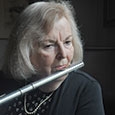By this time in the school year, it is easy to have gotten in a rut. You and your students may be bored with your teaching, playing, or practicing. Changing up a few things can be quite inspirational. A tweak here and a tweak there can do wonders during these last days of winter.
Vary the Location
Do you always teach or practice in the same space? Many practice rooms are windowless and quite small. It is easy to stop projecting when practicing in such an environment. Checking out a classroom, recital hall, or large rehearsal space can do wonders for opening the sound.
For bands, simply rotating the chairs 180 degrees in the band room offers a new sound experience. For rehearsals on the stage, try setting up facing the audience and then the back wall of the stage to illustrate how this changes the reflective sound experiences. An alternate set up may help students solve issues with attacks, tone production, blending, and other musical objectives.
If the band room has built in risers, have students who read treble clef music sit next to someone who reads bass clef music. The goal is for no one to be sitting next to a like instrument. Rehearse in this new seating arrangement for several weeks before returning to the classic set up. This exercise promotes listening from the bottom up and awareness of inner parts.
One of the most productive rehearsals I have ever watched was led by Kenneth Kiesler, director of orchestras and professor of conducting at the University of Michigan. He was guest conducting for a week at the Sewanee Summer Music Festival. Kiesler had the orchestra chairs set up in five circles with the outside row facing towards the center, the fourth row facing out, the third row facing towards the center, the second row facing out and the final row facing in. He conducted from the center of these circles. The final inside circle included the concertmaster, principal second violin, principal viola and cellist who were all facing him. He also mixed up the music folders so no one was sitting with a like instrument but were grouped in clusters of four, mimicking the ranges of soprano, alto, tenor, and bass instruments. He began the rehearsal conducting Brahms’ Tragic Overture, Op. 81 (written in 1880). The only students who could see him were the rows facing in. They had to express what they saw Kiesler conducting to those who were looking out. He rehearsed the piece section by section and then had the students exchange places (those facing out were now facing in etc.) and rehearsed the sections again. The rehearsal was a bit longer than usual, but this proved to be the best played composition on the weekend concert. He had taught the students how to listen to all of the parts and to use body movements to play better together.
Mirror, Mirror
When I taught at the university, there was one classroom with mirrors covering each of the four walls. Whenever I had the opportunity to teach in this room, I always took it because the space offered many benefits. First, both the student and I could view the student’s set up from every angle. This meant that we were on the same page concerning what needed to be improved. Sometimes I taught flute choir in this room. After a session in the mirror room, the ensemble’s playing was always improved. For example, when playing scales in a variety of rhythms and articulation patterns, we could check who was moving rhythmically together and who was not. Once everyone was synced by sight, the ensemble was tighter. The mirrors reflected whether a cue was clear and large enough for others to understand. The mirrors also offered the opportunity for everyone to check placement of feet, arms, and hands and how the head was balanced on the spine. Unwanted tension was also easy to identify and fix. When a student was preparing for a competition or a jury, I always scheduled at least one rehearsal with the pianist in this room. Part of a winning strategy is excellent, confident stage presence. Both players could easily see what the total impression was by looking in the mirrors and make changes so the performance looked polished and professional.
If your school has a dance rehearsal room, schedule sectionals there for each instrument. If possible, have students stand for this sectional. Use the time to work on theoretical technical elements such as scales in various articulations and rhythms. Check to be sure everyone is holding their instrument correctly and moving in time. This is a lesson for using the eyes in performance.
If your school does not have a dance program, look around to other possibilities of rooms with mirrors such as drama department dressing rooms or home economics labs. For students’ home practice, an inexpensive full-length mirror is an excellent purchase.
Clean Up
By February most of us are still living in the clutter of the fall. Take the time to put away music and instruments that are no longer being used. Toss music stands, chairs, parts of uniforms, and instruments that cannot be repaired. An orderly space gets rid of distractions and helps direct everyone’s attention to the music and performance. Make the commitment that today is the day to clean up. I admire directors who can keep a clean rehearsal room. They are true marvels amongst us.
If the clean-up is too large for one person, use a rehearsal and give each section a specific task. As a parent, I found that children keep spaces that they have cleaned and organized themselves more orderly than when I did it. Just a thought.
Renovating the Practice Space
Most teachers set up their studios and leave everything in place year after year. The same can be true of the band room. Within the limitations of the space, consider whether re-arranging the furniture or redecorating could offer a fresh outlook for your teaching. This is also a good time to declutter your office.
Consider the lighting. Many buildings have overhead fluorescent fixtures. Through the years, the bulbs become loose and begin to hum. This humming can be tiring for both you and the student. In school classrooms, make sure all fixtures are working properly and provide sufficient lighting for all parts of the room. If there are windows, do they create glare at certain times of the day or for some areas of the room?
Consider whether the walls or the door to your office could include educational material to catch students’ interest. Changing this up on a regular basis will encourage them to check what is new.
Renovating the Rehearsal
A ongoing objective of teachers is to help students set short term and long-term goals. By this point in the year, a long-term goal might be to play well at band contest or music festival or to learn a particular work. Short term goals tend to be based on how to make this happen.
When I taught in Idaho, the 2000 Winter Olympics were held in Utah just a few hundred miles away. My studio decided to create an Olympic challenge for each section of the band to play all major scales, two octaves, in less than two minutes. A pizza party for the section was the prize. Since the 2022 Winter Olympics will be held this year, why not repeat the challenge? Adjust the goal for your group. It could cover scales, arpeggios, seventh chords, an etude, a rhythmic study, or anything your group needs additional work on. This project provides short-term goals for each week with a defined long-term goal to achieve. Pick a final prize for the students or sections to achieve at the end as they work through the weekly goals.
Teaching Olympic Scales
Teaching scales can be a fun endeavor if approached with logic and definite goals. Here are some tried and true methods to inspire students. With just a few minutes each day, in six weeks your band or private students will be able to play all 12 major scales.
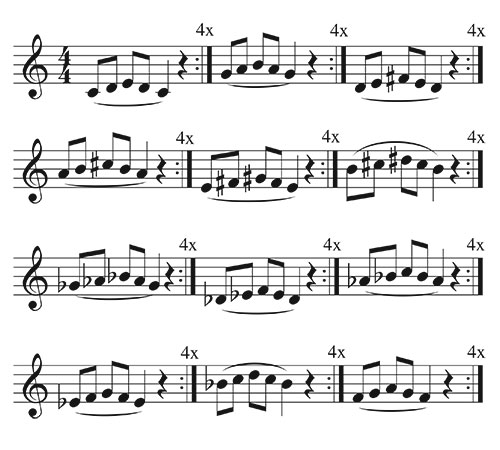
Week 1: Play the first three notes of each major scale (as shown above), going around the circle of fifths clockwise, slurred. Listen for a clean attack on the first note which should be played on the beat and not before. The rest is important. Encourage students to take a sip (quick) breath in each rest. All notes are played on one blow of air.
Week 2: Play the first four notes (or tetrachord) of each major scale, going around the circle of fifths clockwise, slurred. Listen for a clean attack on the first note which should be played on the beat and not before. The rest is important. Encourage students to take a sip (quick) breath in each rest. This will teach how to separate the vocal folds or open the throat when playing.All of the notes are to be played on one blow of air. Explain to students that a tetrachord is a scale of four notes with the interval between the first and last note being a perfect fourth. The following tetrachords are constructed of a whole step, whole step, and half step.
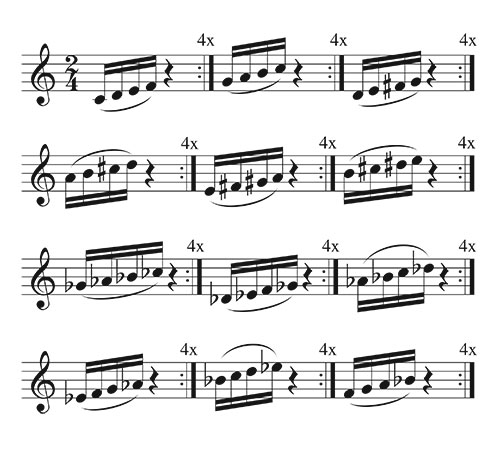
Week 3: Discuss how a major scale is constructed from two tetrachords. Have students play C, D, E, F and then follow with the next tetrachord G, A, B, C to construct a C major scale. Then start with G, A, B, C and add D, E, F#, G etc. If the tetrachords were thoroughly learned in week 2, then this step should be easy to perfect. Play the eight notes in one blow of air. The rest with the breath is still important. Work to play the eight ascending notes quite rapidly like a rip. Some keys will be easier than others, but encourage students to persevere and practice them all.
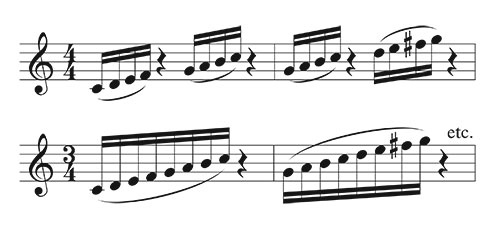
Week 4: The next step is to practice the descending scale. Chunk by 1, 2, 3, 4, rest, 5, 6, 7, 8, rest, 7, 6, 5, 4, rest and then 3, 2, 1 slurring each chunk.

Week 5: During week 5, move on to chunking the two-octave scale. Each chunk is played on one blow of air followed by a rest.
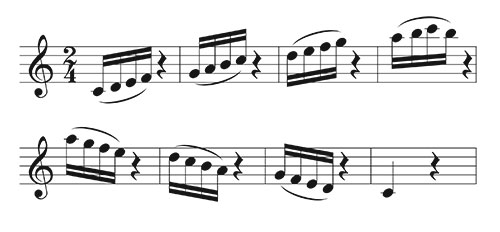
Week 6: Play two-octave scales ascending and descending slurred. If there is a fingering problem between two notes, practice in the following rhythm:
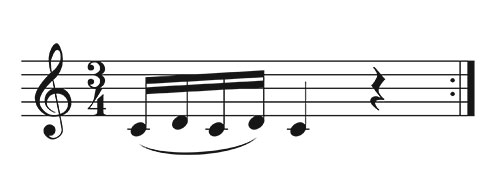
Week 7: Schedule an Olympic play-off, with each section playing all twelve major scales, two-octaves. The sections that achieve the goal you set at the beginning get a pizza party or whatever reward you had selected.

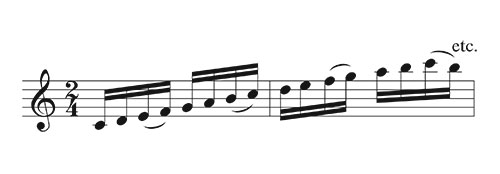
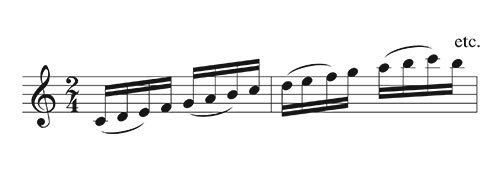
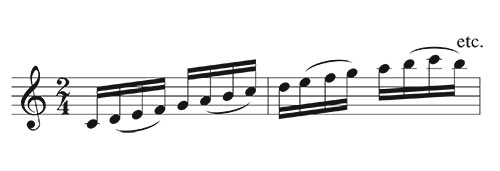

Future Weeks: Practice the major scales with each of the following articulations and rhythms. Ask students to come up with additional variations

After the stress and uncertainty of the past few years, many teachers and students are feeling drained of energy and creativity. By refreshing the rehearsal space and revising the curriculum, teachers can create a fresh perspective and bring back excitement to band or music lessons. A fun goal such as an Olympic Scale might be just the thing to brighten students’ lives and generate renewed interest in practicing and music.
* * *
Refreshing Your Teaching Studio
If you have a private teaching studio, this is a good time to look around the room and evaluate what could be changed there as well. While teaching in Idaho, during a visit to the art department, I noticed several professors had removed the ceiling tiles from their studios. This vastly expanded the cubic space of the room. For a music studio, this could improve the acoustics of the space. However, removing tiles may affect the sound proofing. If the room is too live and has too much echo, then consider fiber wall hangings. I had one wall hanging of a flute player that I had been given by a former student from Guatemala. It was not only interesting to look at, but it absorbed just the right amount of sound. For another studio, I hung an antique quilt.
In private studios, I have seen a trend towards indirect lighting that you may want to consider. You can accomplish this with lamps (both table and floor) and special lamps for the music stand and piano rack. When I changed the lighting in my studio, every student commented how much more relaxing the atmosphere it was. At the end of the day, I realized I was not as tired as normal because I hadn’t listened to the humming of the bulbs for eight hours. While it takes more time to turn on and off the lamps each day, it is well worth the effort.When I was teaching in Idaho, I lived on the edge of a desert so the air was very dry. At certain times of the year, I kept a humidifier running in my studio. Students always remarked how much easier it was to breathe with more humidity.
Plants are excellent for improving the quality of air. If they are well-tended, they can also be an addition to the overall ambiance of the space. Avoid ones with flowers as many people have allergies that can be provoked by them.
Consider repainting the walls. Generally, a color that stays out of the way is best. You can bring personality to the space by hanging art work, diplomas, and concert posters. An inexpensive area rug over worn carpet or tiles can quickly freshen a space.
Even the music equipment you select can be a teaching aid. I have a colleague who purchased several music stands in different colors in addition to the standard black ones. She had students use a red stand to play the Borne Carmen Fantasy, and a silver stand for contemporary music. The stands became a visual prompt to set the character for each piece.
Because students wait for lessons outside your door, consider carefully what you place on the door. Turn this waiting time into a teaching experience and be sure to switch it up regularly. At the beginning of one term, I typed up my favorite quotations from Nadia Boulanger and printed each off on a piece of copy paper. Every Monday morning, I put up a new quotation. My students loved them and it wasn’t long before my colleagues were saying how much these quotations meant to them too.
